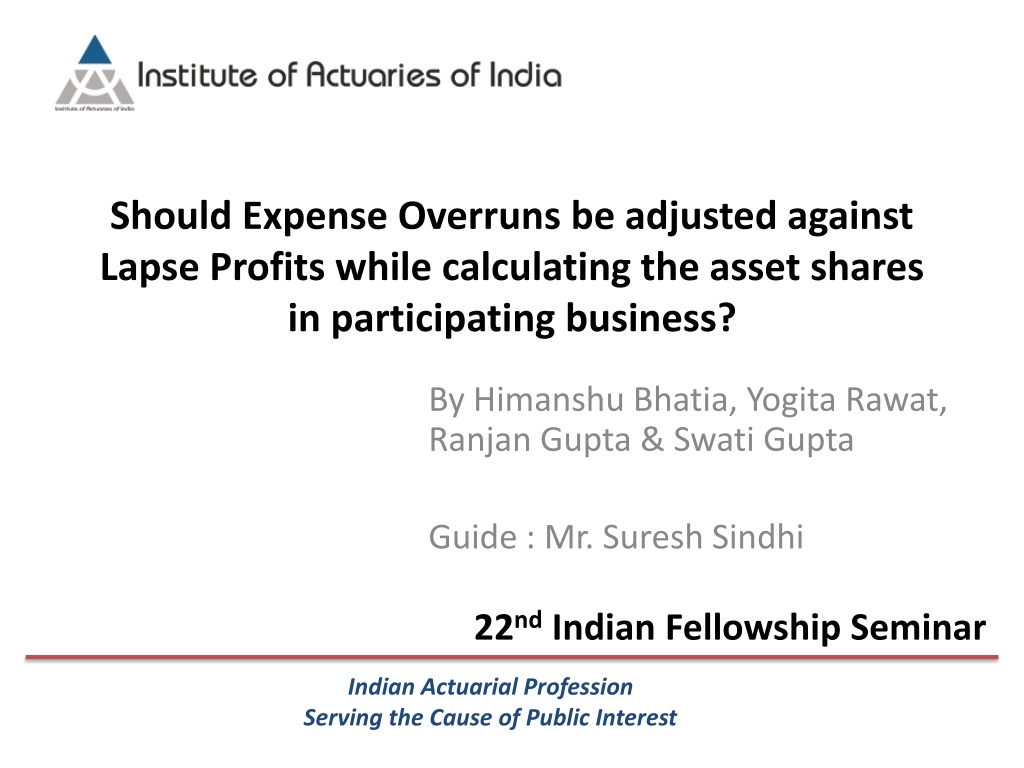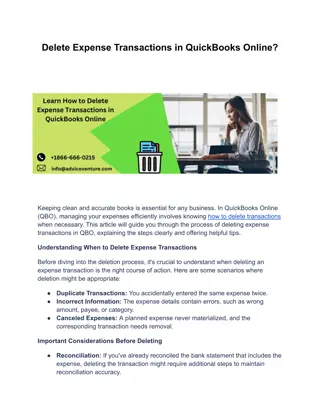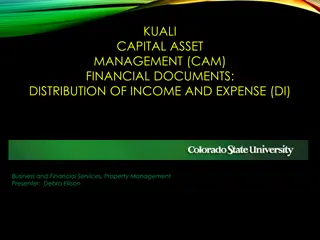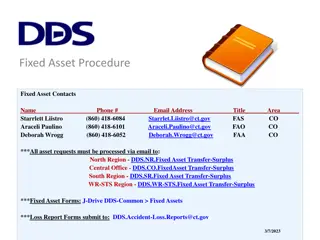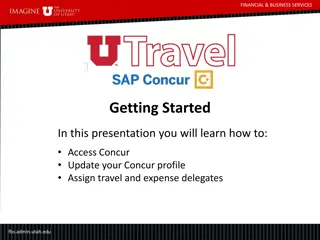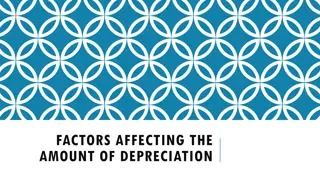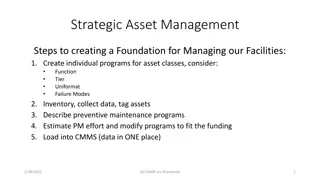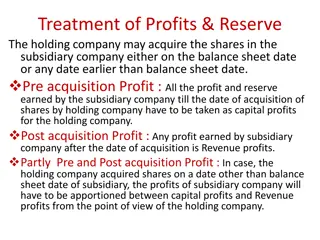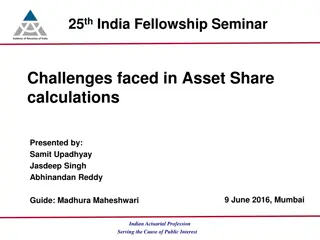Treatment of Expense Overruns and Lapse Profits in Asset Share Calculations
Exploring the adjustment of expense overruns against lapse profits in determining asset shares for participating businesses. The discussion covers factors, distribution of surplus, professional and regulatory frameworks, and scenarios from the UK. Questions and conclusions round off the analysis.
Download Presentation

Please find below an Image/Link to download the presentation.
The content on the website is provided AS IS for your information and personal use only. It may not be sold, licensed, or shared on other websites without obtaining consent from the author. Download presentation by click this link. If you encounter any issues during the download, it is possible that the publisher has removed the file from their server.
E N D
Presentation Transcript
Should Expense Overruns be adjusted against Lapse Profits while calculating the asset shares in participating business? By Himanshu Bhatia, Yogita Rawat, Ranjan Gupta & Swati Gupta Guide : Mr. Suresh Sindhi 22nd Indian Fellowship Seminar Indian Actuarial Profession Serving the Cause of Public Interest
Agenda Introduction Treatment of Expense Overruns & Lapse profits Current scenario Should Expense Overruns be adjusted against Lapse Profits?- Factors Distribution of Surplus Professional Framework Regulatory Framework UK Scenario Summary & Conclusions Questions? www.actuariesindia.org 2
Introduction: Asset share Asset Shares According to GN 6, an asset share for a policy grouping at a given point in time is the accumulation of the premiums received plus investment income earned from the inception of the policies, less deductions due to benefit payments, commission, expenses, tax, a reasonable cost of capital and of guarantees, contribution from miscellaneous surplus (if considered appropriate) and transfers to shareholders. Accumulation of Benefit payments + Commission + Expenses + Tax + COC + COG + Misc. Profit + Transfer to Share Holders Premiums + Investment income - + www.actuariesindia.org 3
Introduction: Uses of Asset Share Asset Shares Uses Bonus rates Surrender Values Maturity Benefits www.actuariesindia.org 4
Treatment of Expense & Lapse profits in Asset Share Treatment of Expense in Asset Shares Treatment of Lapse Profits in Asset Shares Full expenses charged to Asset share Credited to Asset Share Credited to Estate Pricing Expense Expense used in benefit illustrations Long term Best estimate www.actuariesindia.org 5
Expense Overruns High Initial Expenses Many insurance companies still relying on agency and third party distributors which involves high acquisition costs High/significant costs involved in setting up Banc assurance/ Direct Marketing/Online sales Low Volumes of business High Maintenance Costs Expense inflation & salary inflation Enhanced regulatory constraints & reporting Eg. Significant system development required to cater Shadow Accounting and Non-Residual Additions (NRA) Scale of operations www.actuariesindia.org 6
Expense Overruns Treatment of Expense Overruns Alternatives Full expense charged to AS Difference charged to Estate Difference charged to Share holders www.actuariesindia.org 7
Current Scenario Asset Shares calculation current Indian Context$ Treatment of expense overrun 39% charged the difference to the Estate, 31% charged the difference to the Share holder & 31% charged the full expense to the AS Treatment of lapse profits 31% credited to AS while 69% credited to the estate $ Based on India Asset Share Survey by Milliman dated 04.02.2014 (Based on responses from 14 companies out of 24 life insurance companies- representing 58% of total market) www.actuariesindia.org 8
Current Scenario Why is the treatment of expense overruns not uniform across industry??? www.actuariesindia.org 9
Expense Overruns & Lapse Profits The Big Question : Should Expense Overruns be adjusted against Lapse Profits Answer would ideally depend on the following: Age of the Insurer & Par-Fund Par-Fund Estate Company s Par-Fund Management policy Comparison of Actual Lapse profits v/s Assumed Lapse Profits Policyholder Reasonable Expectations(PRE) set by Benefit Illustrations & Other Disclosures Shareholders Attitude & belief: Provisions for expense overruns Practice followed by others in industry www.actuariesindia.org 10
Expense Overruns & Lapse Profits Charging Overruns to Asset Shares Will impact the current generation of policyholders Factors affecting distribution of surplus Professional Framework Regulatory Framework www.actuariesindia.org 11
Par Fund Management Distribution of Surplus: factors to consider Equity among different class/generation of policyholders Market practice and competitors' actions Communications to the policyholders in form of sales illustrations, With profit manual & other correspondence Policyholders reasonable expectations and sales practices used Shareholders role to support the business initially Merge of expense overruns in best estimates expenses Professional obligations and Regulatory framework www.actuariesindia.org 12
Par Fund Management Asset Shares Vs Par Fund Estate Reversionary Bonus v/s Terminal Bonus rates Surrender Values Maturity Benefits www.actuariesindia.org 13
Professional Framework GN 6 AA must consider the consistency of expenses being charged to asset shares with what has and is being illustrated to customers. Actual allocation to Asset Share w.r.t. renewal expense can vary on discretion as long as Policy holders reasonable expectations (PRE) encompass www.actuariesindia.org 14
Professional Framework GN 6 The amount of expenses charged to the historical asset share of policies a) The Appointed Actuary must consider the consistency of expenses being charged to asset shares with what has and is being illustrated to customers. In particular, the expenses intended to be allocated to the asset shares should be consistent with the bonuses projected in benefit illustrations. b) In respect of renewal expenses, so long as policyholders reasonable expectations encompass expense risk, the Appointed Actuary, when making the actual allocation to asset shares, may use a degree of discretion in departing from the expenses implicit in any benefit illustration issued at point of sale. However, in respect of acquisition expenses, the level of expense should be known with greater certainty. Hence, the Appointed Actuary will have less scope to depart from the level of expense implicit in any benefit illustration when allocating acquisition expenses to asset shares. The Appointed Actuary should document any such departure. www.actuariesindia.org 15
Professional Framework GN 6 c) Where the expenses allocated to the fund exceed those allocated to the asset shares, the Appointed Actuary should consider the reasons for this, and be satisfied that the approach: i. is sustainable; ii. is not, by its effect on the estate, expected to affect policyholders reasonable expectations adversely and materially; and iii. is appropriately reflected in the expenses assumed in the statutory valuation of liabilities. www.actuariesindia.org 16
Regulatory Framework IRDA(Non-Linked Products) 2013 Regulations Special Surrender Value(SSV) shall represent the asset share in case of the par policies, where the asset share shall be determined in accordance with the guidance or practice standards issued by the Institute of Actuaries of India With Profits Committee (WPC) Independent committee w. r. t. Decisions related to Par business www.actuariesindia.org 17
UK Framework Role of PPFM: A mandatory with profit guide Role of Estate Investment Flexibility Requirements of Regulatory capital Payment of Tax incurred by fund on distribution to shareholders Covering overruns on existing & new business expense Smoothing flexibility Regulatory Approval for difference in pattern of distribution as compared to previous practice www.actuariesindia.org 18
Summary & Conclusion: The bigger picture! Answer depends on various factors Role of Professional body & Regulatory Body Freedom given to industry by the virtue of various provisions of applicable Professional & Regulatory framework keeping in view Sustainability of Fund, PREs, Equity Considerations, Shareholder Approach & Overall Objectives of Business Charging the overruns to asset share might be the only option for sustainability of the company and policyholders ultimately Charging the overruns to estate would serve as a balancing act Charging the overruns to share holders would ultimately lead to fair policyholder treatment & curtailing expenses www.actuariesindia.org 19
Time for Two way discussion www.actuariesindia.org 20
